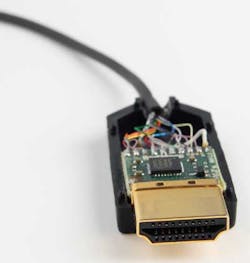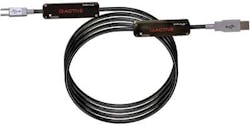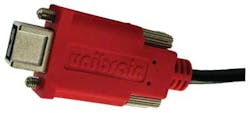PRODUCT FOCUS - Active Cables Lengthen Camera-to-Computer Connectivity
Andrew Wilson, Editor
Today's camera interface standards encompass high-speed point-to-point protocols such as Camera Link as well as slower bus-based and network-based standards such as FireWire and Gigabit Ethernet. To transfer images between these cameras and host computers, cable, connector, and interface vendors supply a range of products that comprises copper cabling, custom connectors, and fiberoptic-based interfaces. Vendors have recognized the distance limitations of these standard interfaces and have begun to offer various active cable products.
Unlike their passive cable counterparts, active cables intended for camera-to-computer data transfer employ specialized circuitry either embedded in the cable connector or as part of the cable to improve the signal attenuation, crosstalk, and signal skew associated with passive cables. Suppliers that design active cables can overcome the distance limitations set down in standards such as Camera Link, USB, and FireWire, offering developers single, longer-length cables with less signal degradation. By employing circuitry, these more expensive cables often offer up to five times the data transfer distance of their passive counterparts.
Overcoming distance limitations
Different machine-vision interface standards are specified to operate at specific distances using passive cable. For example, the Camera Link specification defines a maximum cable length of 10 m; in comparison, the maximum cable length of FireWire (1394a) allows a camera-to-computer distance of 4.5 m. Whether such cables can transfer images at these cable lengths is a matter of debate, since longer cable lengths can give rise to increased jitter and signal attenuation due to transmission loss in the cable. This results in a closed eye pattern at the receiver or frame grabber in which neither the data nor the clock signal can be recovered.
Methods such as de-emphasis can be used to increase the amplitude of the data being transmitted. However, in high-speed data transmission standards that require extended cable lengths, this technique alone is not sufficient. In such cases, equalization techniques that include transmit side de-emphasis, feedforward equalization (FFE), decision feedback equalization (DFE), and continuous time filtering are used to ensure that the signal generated by the camera is faithfully reproduced at the frame grabber.
Luckily, a number of IC vendors—most notably EqcoLogic, Intersil, National Semiconductor, Maxim, Redmere, and Gennum—have developed driver/equalizer chipsets that use equalization techniques to allow camera, frame grabber, and "smart cable" vendors to extend the reach of camera-to-computer interfaces.
Following the development of the CoaXPress standard, camera vendors such as Adimec and Optronis and frame grabber vendors such as Active Silicon and Bitflow incorporated both EqcoLogic's transmitters and receivers into their respective products. Although these devices are embedded in the cameras and frame grabbers—and not the coaxial cable used to interface the two—the use of the EQCO62T20/EQCO62R20 driver/equalizer chipset allows up to 6.25 Gbits/s of data to be transferred over a downlink channel and 21 Mbits/s to be transmitted over an uplink channel. According to EqcoLogic, this allows data to be transmitted at distances up to 58 m (at 6.25Gbits/s) and 100 m (at 3.1 Gbits/s) using RG11 cable.
Smart cable designs
Not only does this type of chipset form the heart of the CoaXPress standard but is also being used by manufacturers in smart cable designs. Rather than incorporate the equalizers into the cameras and frame grabbers themselves, cable vendors are integrating them into the connectors and cables. Therefore, active cables for well-known machine-vision interface standards such as Camera Link, Camera Link HS, FireWire, and USB; at present less frequently adopted standards such as 10GigE, HD-SDI, and USB 3.0; and emerging standards such as Apple's Thunderbolt are now available for connecting cameras to computers at long distances.
Although equalizers permit longer cables or higher data rates, they are often used with transceivers that transmit the data and power over conventional cables. Which type of device is used in these designs is dependent on both the type of camera-to-computer interface and breed of cable being used. High-speed unidirectional or asymmetrically bidirectional interfaces such as HDMI may require signal conditioning at the transmitter, receiver, or transmitter and receiver sides of the cable, whereas bidirectional interfaces such as USB 3.0 and FireWire often use a pair of devices at both receiver and transmitter sides.
Maarten Kuijk, chief technical officer of EqcoLogic, explains, "For unidirectional links, equalization can be performed on either side of the cable or both sides. However, the amount of higher-frequency compensation applied is typically dependent on cable length and type. Thus, if only limited compensation is required, a fixed equalizer can be used because these variations will also be of limited importance."
This is the approach taken by Components Express in the design of its Bit Maxx, a Camera Link cable extender that—although not embedded into the connector housing—uses pre-emphasis and equalization techniques at the camera (transmitter) side of the cable to extend camera-to-computer distances to 30 m. Offered in two versions that support Base and Full Camera Link modes, the unit allows cables to reach more than 25 m in Base mode at 85 MHz, 18 m in Full mode at 85 MHz, and more than 30 m at lower clock speeds (see "Camera Connections," Vision Systems Design, September 2010).
Adaptive equalization
"When higher compensation levels (e.g., greater than 10 dB) are required or where bit errors must be eliminated," says Kuijk, "it is better to use adaptive equalization techniques." Adaptive equalization must be performed with an equalizer at the receive end of the cable; this will result in less jitter and a wider eye pattern. So, for industrial applications that demand low bit-error rates and may operate over wide temperature ranges, it is better to have an adaptive equalizer at the receive side of the cable.
PNY Technologies has taken this approach in the design of its active high-speed HDMI micro cable that can transmit HDMI data at distances up to 10 ft (see Fig. 1). Using the RM1689 equalizer from Redmere embedded in the receive-end connector, the company claims that device allows 70% of the copper and PVC to be removed from the manufacturing process of a high-definition video cable.
"Although it would appear better to have a degree of pre-emphasis at the source end and then an equalizer at the termination, there are a number of reasons why only equalization is used at termination," says Darren Hobbs, product marketing director at Redmere. "These include the facts that all transmitters specified to meet the HDMI standard must already have a degree of pre-emphasis; it is mechanically quite difficult and expensive to place active components into a micro-HDMI connector; and pre-emphasis at the source side alone is not quite as scalable a solution across multiple cable-length skews. In addition, aspects such as EMI [electromagnetic interference] become more prevalent as more energy is applied to the source-end signal."
Bidirectional interfaces
For bidirectional interfaces, such as USB and Apple's latest Thunderbolt interface, equalizers are typically found on both sides of the cable. To extend the reach of USB cables using equalization techniques, Icron Technologies and Intersil have jointly developed a USB 3.0 cable that delivers 5 Gbits/s of throughput over 20 m (see Fig. 2).
To achieve this distance, the USB 3.0 active extended-reach cable assembly consists of two USB connectors with embedded printed circuit board assemblies (PCBAs) connected by a twin-axial copper cable containing five shielded differential pairs. These differential pairs are terminated at each end to the PCBAs, with each PCBA containing two major subsystems: a USB 3.0 extended-reach system that runs over two differential pairs and a USB 2.0 extended-reach system that also runs over two differential pairs.
The USB 3.0 system consists of the Intersil QLx4600-S30 6-Gbit/s lane extender embedded at each end of the cable assembly, which equalizes and compensates for frequency-dependent attenuation of non-return-to-zero data and extends the signal reach to more than three times the reach achievable over passive copper cables.
In its latest incarnation of Intel's previously code-named LightPeak technology, now known as Thunderbolt, Apple Computer has also used equalization techniques in the design of its 2-m Thunderbolt interface cable. At each end of the connector, a GN2033 transceiver/equalizer IC from Gennum is used to provide dual bidirectional 10-Gbit/s concurrent links over narrow-gauge copper wires.
Coaxial cable
Several ICs are also available from EqcoLogic to allow bidirectional communication and power to be transmitted over a single coaxial cable. "This is only possible," says Kuijk, "because coaxial cable is a well-defined communication medium, with fixed impedance from end to end; and unlike shielded twisted pairs that exhibit skew due to length differences between the two wires, no skew is possible with coax cable. Furthermore, there is less attenuation for similar cable diameter, since only one wire is susceptible to the so-called ‘skin effect' of the cable."
Using EqcoLogic's equalizers, Unibrain has developed two different coaxial cables that support the FireWire 800 standard—which extends the cable distances to 65 and 130 ft, respectively—and incorporate standard nine-pin to nine-pin ports at either end of the cable (see Fig. 3). In employing pairs of equalizers, any differences in transmission amplitude are removed by the input pre-driver. The receiver equalizer then uses variable gain to compensate for attenuation through the transmission line.
In the past, developers of machine-vision systems were somewhat limited in their choices of camera and computer systems by the very cables needed to connect them. However, with the advent of embedded equalizers and transceivers, the limitations of cable length that may have held back the deployment of certain standards-based camera systems are being rapidly overcome. For cable manufacturers and system integrators alike, these advances will also reduce the amount of copper and weight of cables, and offer an alternative to more power-hungry optical alternatives.
Company Info
Active Silicon
Iver, UK
www.activesilicon.com
Adimec
Eindhoven, the Netherlands
www.adimec.com
Apple Computer
Cupertino, CA, USA
www.apple.com
Bitflow
Woburn, MA, USA
www.bitflow.com
Components Express
Woodridge, IL, USA
www.componentsexpress.com
EqcoLogic
Brussels, Belgium
www.eqcologic.com
Gennum
Burlington, ON, Canada
www.gennum.com
Icron
Burnaby, BC, Canada
www.icron.com
Intersil
Milpitas, CA, USA
www.intersil.com
Maxim
Sunnyvale, CA, USA
www.maxim-ic.com
National Semiconductor
Santa Clara, CA, USA
www.national.com
Optronis
Kehl, Germany
www.optronis.com
PNY Technologies
Parsippany, NJ, USA
www3.pny.com
Redmere
Balbriggan, Co. Dublin, Ireland
www.redmere.com
Unibrain
San Ramon, CA, USA
www.unibrain.com




